Samsung S95C Reviewed at $2,499.00 (55")
Product Name: Samsung S95C
Product Description: 2023 4K QD-OLED TV
-
Design - 9.6/10
9.6/10
-
Video Quality - 9.4/10
9.4/10
-
Ports & Connectivity - 9.6/10
9.6/10
-
OS, Apps and Features - 9.4/10
9.4/10
-
Price / Quality - 9/10
9/10
Summary
Reviewed at $2,499.00 (55″)
Pros
- Excellent brightness
- Amazing blacks
- Perfect for gaming
- Huge list of features in Tizen
Cons
- ABL a bit too aggressive
- No Dolby Vision
- No DTS support
- More expensive than last year
Cheapest Places to Buy :
*We are a reader-supported website. When you buy through links on our site, we may earn a small affiliate commission at no extra cost to you. Home Media Entertainment does not accept money for reviews.*
As we slowly approach the summer more and more of the new 2023 TVs that we saw during CES 2023 are starting to appear on the market. And what better way to start our foray into the 2023 models by looking at Samsung’s 4K QD-OLED flagship. In our Samsung S95C review we will be testing this new TV that has just been released and dive deep into the changes and upgrades Samsung did over the last year.

The Samsung S95C replaces the 2022 S95B which had an arguably bumpy start. But after some upgrades Samsung managed to show its true potential and become one of the best TVs for last year. In 2023 we enter the second generation of QD-OLED technology and with it Samsung did some noticeable improvements.
But let’s see what the S95C is all about very quickly. The new TV uses an upgraded, 144Hz capable, QD-OLED panel along with Samsung’s Neural Quantum Processor 4K. For sound it has the Object Tracking Sound+ System along with Dolby Atmos support. It also comes with four 48Gbps HDMI 2.1 ports being placed in the separate One Connect Box. There is support for HDR10+, but not Dolby Vision, and is equipped with Samsung’s latest Tizen OS 2023.
Looking at the specs the major differences this year seem to be the upgraded QD-OLED panel. In theory this has higher white and color luminance and better durability than the 2022 model. And obviously the use of the Once Connect Box which resulted in a complete overhaul of the TV design. Are these changes enough to make the new S95C the better of the two? Let’s start our analysis to find out.
Design
Let’s talk about its design first. The S95B, being basically an OLED, had an undoubtedly great design with a slim profile that had the obvious electronics box at the back. For the S95C Samsung changed their thinking completely. By deciding to use their proprietary One Connect Box allowed them to do two major changes, or upgrades if you like.
Measurements
The first one is that moving all the electronics away from the main body gave them the opportunity to create a completely uniform design without any extrudes at the back. Its completely flat back side means that if you want to place it on the wall the gap from it will be much small and thus look far better. We measured the thickness of the TV about 0.5″ (1.3 cm). This is a huge difference compared to the 1.6″ (4 cm) thickness of the S95B.
The second change was that with such a new chassis Samsung was able to include a better audio system. But more on this on the dedicated audio section.
Its black borders were very thin. And from what we saw they were very similar to the S95B, making the whole screen very immersive.
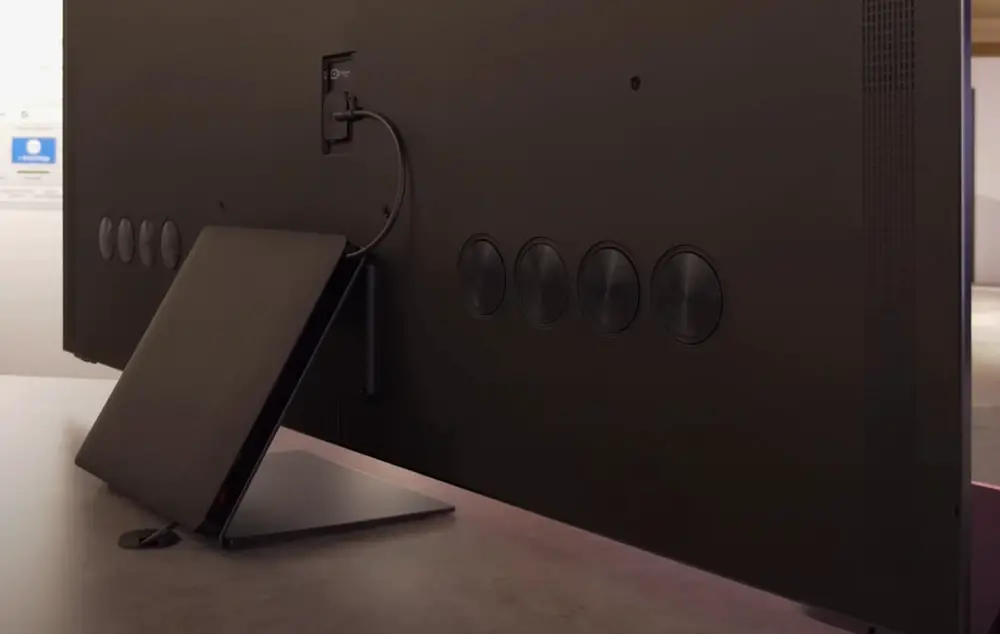
Back Side
The back of the TV, as we already mentioned, is completely different. Here we find the VESA mounting holes in the middle surrounding the only two ports available. A USB Type-A and the One Connect Box port. We also see the audio system. But other than that it is a pretty plain sight with a repeating groovy design.
Stand
The TV uses a small central stand that is made out of metal. As a result the TV may wobble slightly, especially the bigger sizes. So make sure it is placed in a safe position. At least with such a stand you don’t need to have a fairly large surface to place it on. With this stand the clearance between the screen and the surface is about 3″ which is more or less the same as what we measured in the S95B. This means that most soundbars should fit under it without a problem. Just make sure to measure beforehand just to be safe.
The stand looks similar to last year’s offering but it is not the same. The one we get this year is designed in such a way to be able to incorporate the One Connect Box on top of it. This way you have the option to either place it in a different position or have it close to the panel itself. The choice is really yours.
Remote
As for its remote, the One Remote that you will find in the S95C looks similar to the year before. But there are some minor design changes. The new remote lost one button at the top and it has a slightly different design with more round corners in all sides.

It is still small and uses very few buttons as it relies on the TV’s UI for most of its functions. It comes with a rechargeable battery that can be charged either through a USB-C cable or from its solar equipped back side.
Although the remote is not very different we can admit that we liked the 2022 design a bit better. This obviously comes down to personal taste. But the all round corners design this year feels a bit cheaper and less premium. But in terms of functionality they are almost entirely the same.
Overall the Samsung S95C looks spectacular. The 2022 S95B was already a really great looking TV. But adding the One Connect Box this year was really the right decision. As it is right now we can say that the S95C may well be the most good looking TV we have seen to this day. But can it perform accordingly? This is what we are going to test next.
Video Quality
Processor technology used
As with all Samsung TVs, the S95C uses a custom made chip that the Korean manufacturer calls Neural Quantum Processor 4K. Keep in mind that this is exactly the same name the 2022 S95B used. But in terms of features they seem to be very close. So we cannot really say if this is the exact same chip or if there are any upgrades over last year.

What we do know is that this processor uses up to 20 different neural network models. Each is trained in AI upscaling and deep learning technology, in order for the processor to optimize picture quality to 4K picture output regardless of the input quality.
Also its Real Depth Enhancer feature automatically separates objects in the content from the background and creates 3D like depth in order to make the image even more immersive.
Lastly the S95C’s processor seems to carry the latest IntelliSense v2.0 algorithms. These work with the upgraded panel in order boost the picture quality ever more than what was previously possible.
Resolution and Up-scaling
For our tests, as always, we used some videos in different resolutions. From low quality 480p all the way up to 1080p, everything upscaled nicely to the panel’s 4K resolution. We didn’t notice any artifacts due to the upscaling process and everything rendered nicely and how they should be.
Audio Processing
In terms of audio we do get an upgrade but more on this in our dedicated section below. The use of the One Connect Box resulted in the inclusion of the more advanced Object Tracking Sound+ (OTS+) instead of the inferior OTS system in the S95B.

Lighting technology used
The main strength of the S95B was the use, for the first time, of a QD-OLED panel. This had all the strengths of OLED technology married with Quantum Dot. This allowed the display to show better and more accurate colors. And S95C seems to take this one step further as the new model uses the 2nd generation of Samsung’s QD-OLED technology. And this comes with some interesting upgrades.
OLED Technology
Traditional OLED panels feature self emitting pixels. As a result these TVs have no need for a backlight as we see in LED LCD models. Being able to control it’s individual pixels has many advantages. The most obvious ones being the extremely accurate light control and the infinite contrast they have. Deep blacks on an OLED is a sight that needs to be seen to be believed.
On the other hand the problem with OLEDs is that they cannot reach the high brightness output of LED LCD TVs. This has been a problem since the inception of OLED panels. And although there had been some developments like Panasonic’s solution to add a heatsink, in order to push the panel more without damaging it, OLEDs still remained a distant second when it came to peak brightness output.
And this is where QD-OLED comes into play. This hybrid design is meant to take all the strengths OLED has and mixing it with Quantum Dot technology. This results in a boost in brightness and color reproduction to levels that were not possible with the panels available till now.

2nd Generation QD-OLED
Now, in its 2nd generation Samsung added a new layer on the panel featuring a much more efficient blue electroluminescent material. And the addition of its improved IntelliSense AI v2.0 allows the new panel to reach higher white and color luminance. It also has better durability than its 2022 counterpart and lower power consumption.
One thing that we need to mention, something that was also visible in the S95B, is that due to the unusual subpixel structure of QD-OLED you may notice some green or red lines in content that have black bars on top or bottom of the screen. Also because of this, using the S95C as a PC monitor may not have the most clear text among the top tier models. It seems that this minor but nevertheless obvious problem that the S95B had is present here also.
Samsung took an already great technology and made even further improvements to it. Even if they again used their 2022 version we would be happy. But Samsung is trying to push the envelope every year and the S95C is the result of all their labors. Kudos to them for such an amazing technology.
Brightness / Contrast
So, once again, one of the most interesting points in this year’s review could not be other than our brightness tests. With the S95B already performing exceptionally here we were curious how much better the new S95C can do. Especially considering all the improvements Samsung did for the 2023 model.

SDR and HDR Measurements
First test here is the SDR brightness over a 10% window. And the number we got was 640 nits which is really good and will suffice for any kind of SDR content.
We then switched to HDR content and in our HDR brightness over a 10% window test we measured 1315 nits. This is exceptionally good and in fact these numbers bring QD-OLED dangerously close to LED LCD territory.
Automatic Brightness Limiter (ABL)
As with all OLED TVs, the S95C comes with an Automatic Brightness Limiter (ABL). This lowers the overall brightness of the screen when large parts of it become very bright for a long period of time. This may not be very obvious when watching a movie for example. But it shows more with bright static images, or if you use the TV as a computer monitor.
There is a Peak Brightness option that you can turn off if this change of brightness bothers you. But keep in mind that this will set the TV’s peak brightness at a much lower level. At least it is good that you have this choice to choose what you like the most.
Last Year Comparison
Overall, the above values indicate that the S95C saw an increase in overall brightness of about 30%. Which is totally shocking, considering how good the S95B already was. Obviously this increase is not constant. As the S95C will dim faster when the content keeps pushing for a lot of brightness for a long period of time. But even so the numbers are impressive.
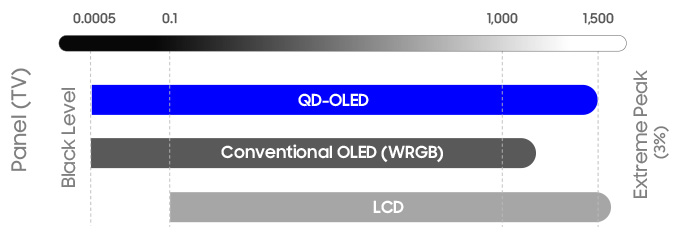
EOTF Tracking
Brightness levels followed the EOTF reference values extremely close up to its sharp roll-off point. This results in some clipping. In order to be able to get such accurate results you need to use either the Filmmaker or the Movie mode. All other modes were far less accurate.
Contrast Performance
As for contrast, having an OLED panel means that the S95C can switch off its pixels entirely. This means it has almost infinite contrast ratio resulting in true deep blacks compared to greyish blacks we see in many LCD models. Lastly panel uniformity was very good and we didn’t notice any major brightness variations or any dirty screen effect across the panel.
Overall we must admit that the S95C surprised us. We knew that the new panel it is using could do better than last year’s version. But we didn’t expect to see such an improvement. The S95C finally showed us that the days when the OLEDs would be the underdog in the brightness category, compared to LCD, are long gone.
Viewing angles
OLED TVs always had the upper hand when it came to viewing angles. And it seems that with QD-OLED things are even better now. Comparing the S95C with the S95B did not show any noticeable differences. The two TVs behaved almost the same. This is as good as it gets considering that last year’s model was already almost perfect in this area.
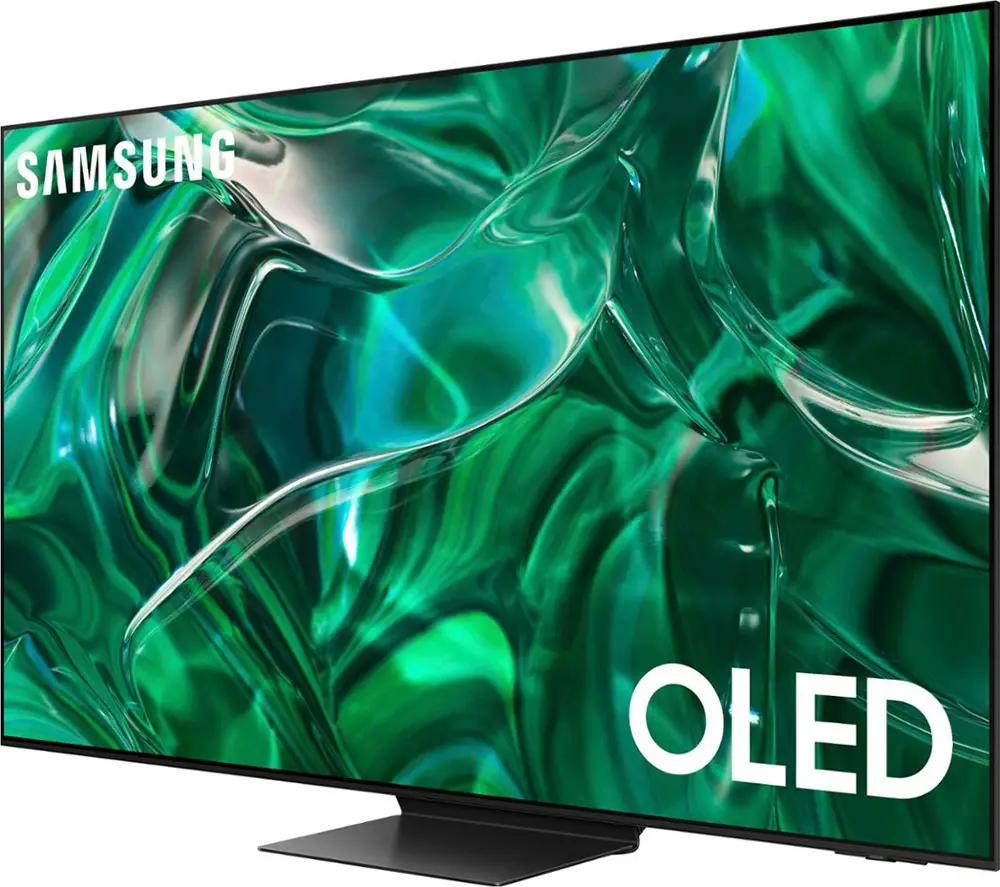
In general, light has a linearity, so when viewing a display, it affects the brightness or color depending on which angle you look at the screen. With the characteristic of QD-OLED to emit light uniformly in all directions, the QD display provides optimal image quality. It does that by delivering uniform luminance and color regardless of viewing angle.
As a result the S95C is capable of exceeding the viewing angle levels we see on most OLED TVS while keeping its image quality at almost the same level. Even at extreme angles of up to 70 degrees the image properties of the S95C were almost the same as watching the TV dead center which was impressive to say the least.
With QD-OLED viewing angles are perfect and this continues in 2023. No major change here and to be honest there is hardly anything better that manufacturers can do here.
HDR support
HDR support is another area where Samsung didn’t changed anything this year. In fact there is no change for a few good years now as most brands stick to their guns. As such we get the most basic HDR10 that is required for 4K UHD playback. There is also HLG that is used mainly for broadcasting. And lastly the newer HDR10+ which is the most advanced HDR protocol. This uses dynamic metadata in order to provide the best image quality on a frame by frame basis, similar to what Dolby Vision is doing.
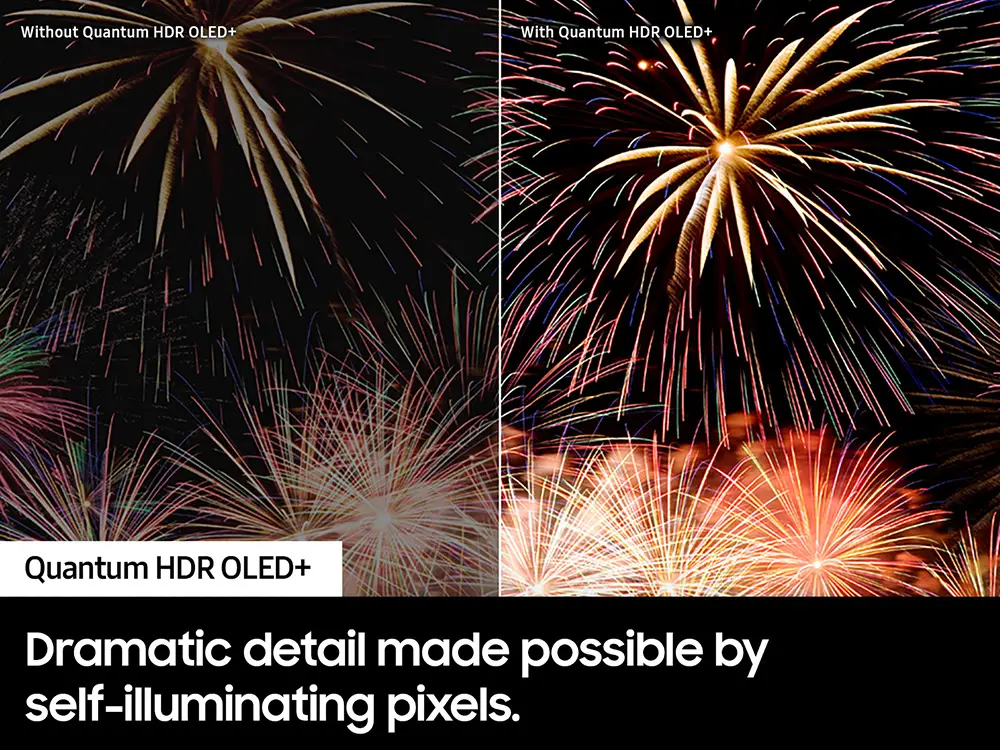
The S95C comes also with HDR10+ Adaptive and HDR10+ Gaming. HDR10+ Adaptive uses its AI engine to analyze the viewing environment. This includes the lighting, brightness and even reflections using the sensors equipped on the TV. The results are then incorporated into the dynamic metadata, and then through four further steps, the brightness and contrast of a scene are optimized. This way you can view HDR10+ movies and television programs in various environments at home.
One new HDR setting in the S95C is that HDR Tone Mapping can now be turned off. This way the TV is able to reproduce HDR10 content more faithfully to the creator’s intent.
Unfortunately, on the other hand, Samsung still refuses to allow Dolby Vision in their TVs and stay firm behind their own HDR10+. A big disappointment but not entirely unexpected.
Color coverage
Lets see how the S95C can do with colors next. Like its predecessor, the TV uses Quantum Dot technology to display more lifelike colors and this was very evident in last year’s release. Does the new S95C behave the same?
The TV can cover the full 100% of the DCI-P3 color space while in the wider REC.2020 we measured 89% coverage. Compared to the S95B these numbers are almost the same so we didn’t see any noteworthy difference here.
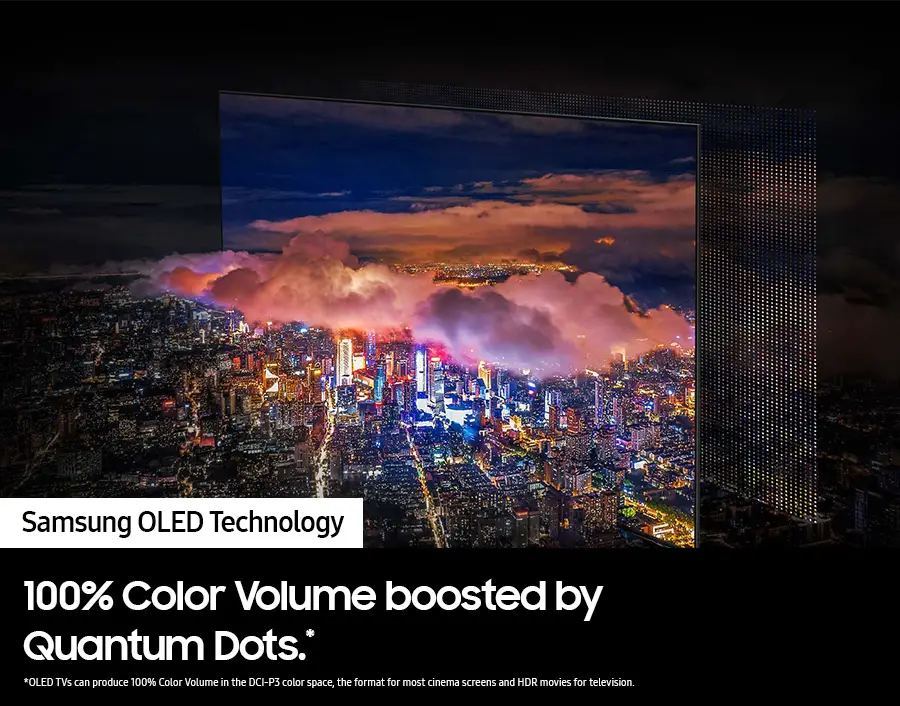
DeltaE Errors
Before calibration the S95C had amazing color accuracy with very minor inconsistences. White balance, gamma and color temperature were very close to their target values. Most colors had values below the DeltaE limit of three with the exception of red which seemed to be slightly above it. But even that was corrected after calibration.
Color Gradients
Color gradients were really good with only some minor banding that we noticed in darker grey shades. But with real content this was completely invisible. There is also a Noise Reduction function in case you do see it. But we believe that the TV did so good that you are not going to need it.
Motion performance
We will be looking at the TV’s motion performance next. Here the S95C behaved very similarly to last year’s offering both in terms of quality and number of features included. This year’s release has one major or not so major, depending how you see it, upgrade over the S95B.
Samsung has included what they call Motion Xcelerator Turbo Pro. This is different from the “Plus” version that we found in last year’s model. Its main difference is its ability to support up to 144Hz, officially this time, which was not the case in the S95B.
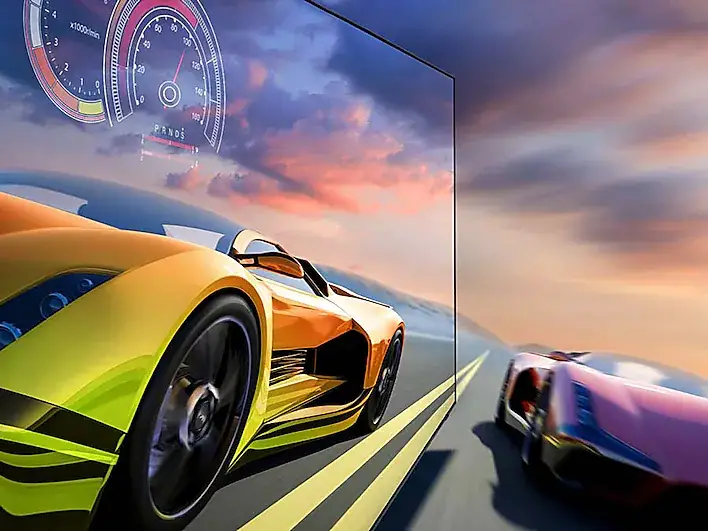
As usual, being an OLED it doesn’t need a backlight to light its pixels. And while in theory this makes the S95C flicker free in reality this is not the case. But this minor flickering is so small that is not visible to the naked eye.
Motion Interpolation
The TV also comes with the usual Motion Interpolation feature. This can smooth motion and remove blur and judder from fast camera movements. Motion interpolation did a really good job overall as we noticed only minimal artifacts during the process. And these were mostly due to the very fast camera moves during each scene.
Obviously using very aggressive settings will make the familiar “Soap Opera Effect” to appear. So keep in mind to adjust the settings accordingly. You can enable motion interpolation by going in the Picture Clarity settings in the menu. By adjusting the two sliders for blur or judder you can set them according to your preferences.
Black Frame Insertion (BFI)
Black Frame Insertion (BFI) is also available, as usual, which can be enabled in the menu with the Clear Motion option. BFI is a technique that inserts a black frame in between two individual frames in order to smooth out motion. Although the end result is very good it has a couple of side effects. First due to the black frames inserted, brightness takes a visible hit. Also due to the lower frequency used, as it can flicker only at 60Hz, you may notice some flickering.
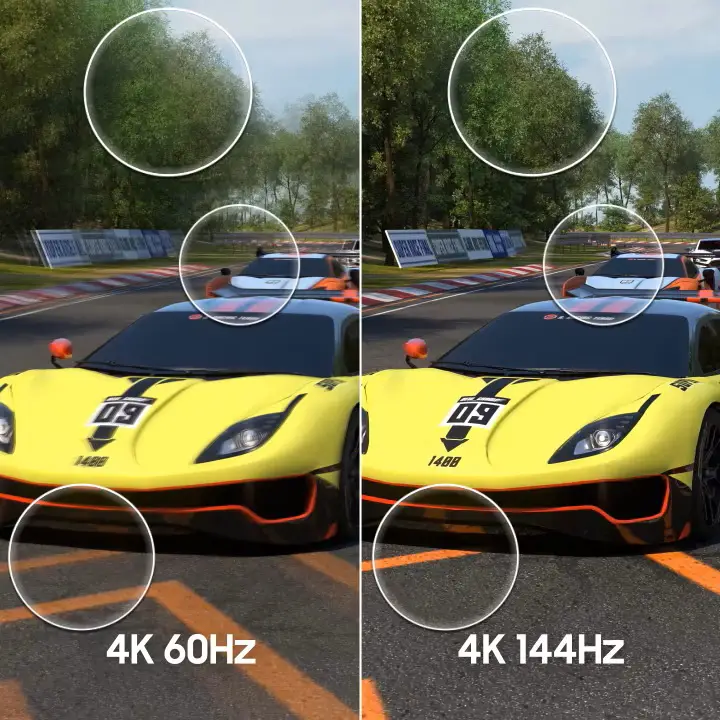
Overall Motion Impressions
The big difference this year is the official support of 144Hz, although this is relevant only if you are a hardcore gamer. For casual gaming or movies this has no effect on the TV’s overall presentation. And from what we saw in our tests the TV behaved very close to last year’s model. This means an almost judder-free experience with low framerate 24p content and good handling in gaming content. Especially in high frame rate games.
Input lag Measurements
Next we will test the TV’s input lag performance. Judging by the numbers we saw in the S95B last year we expect to get similar performance here also.
According to our measurements the S95C measured an average of 9.5ms input lag in both 1080p and 4K resolutions at 60Hz. To be honest this is just about what we were expecting to see. At 120Hz we measured 5.3ms in both 1080p and 4K resolutions which again is as good as it gets.
With the TV officially supporting 144Hz we also tested this in 1080p and 4K resolutions and the numbers we got were 4.5ms and 4.4ms respectively. Just to note here that both the Playstation 5 and Xbox series X support up to 120Hz. So in order to enjoy this higher frame rate you will need a high profile gaming PC.
With such low figures, gaming can really be a pleasure. But in order to get so low values you need to use the available Game mode. Outside Game mode we still got a respectable 78.5ms which is ok for slow paced offline games. But it is too much for online gaming that requires blazing fast response times.
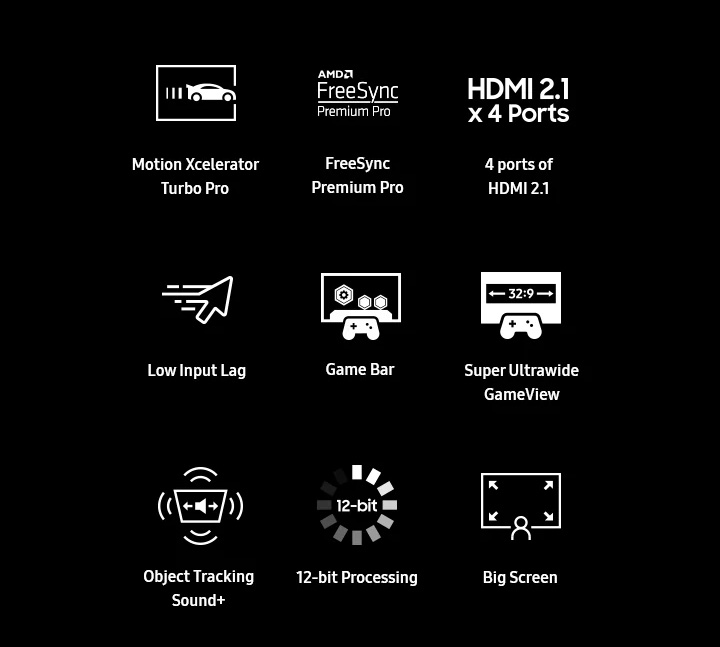
Other Gaming Features
We should also not forget to mention that the TV supports Auto Low Latency Mode (ALLM). This will work when it detects any devices that support that, like the PS5 and Xbox consoles. We also get HGiG Mode which is HDR Gaming Interest Group’s technology. This ensures you enjoy HDR games the way that their creators and developers intended.
VRR Support
The S95C comes with support for all VRR technologies including HDMI Forum VRR, AMD FreeSync and NVIDIA G-Sync. All of them can be enabled in the renamed Game Bar 3.0.
A couple of things that we noticed when enabling 144Hz is that the S95B allows this high frame rate along with 4K resolution and HDR. But on the other hand you cannot choose anything else other than 8 bit color depth no matter what chroma resolution we would choose.
One feature that the S95B got through a firmware update was the new Samsung Gaming Hub. And it seems that the new S95C includes it from the start. With it you can use various online gaming services but as always the kind of content you will find depends on the region you will be using it.
Trying Out a Few Games
Before we move on we connected both our PS5 and Xbox series X and tried a bit of Call of Duty: Modern Warfare 2. The game supports 120Hz in both consoles. What we got was butter smooth motion, very fast response times and no visible delays. In one word excellent, especially if you are very serious about your gaming experience.
Overall Image Quality Impressions
The S95B left us with mixed initial impressions due to some questionable decisions by Samsung. But it seems that for 2023 they decided to fix all wrongdoing. The S95C is every bit as impressive as the S95B was. And it even managed to improve upon it, in some areas more than others.
As a result, this year we have a TV that retained its excellent upscaling capabilities, color reproduction, viewing angles, gaming features and solid motion. But it managed to further improve its brightness output and added 144Hz refresh rate, officially this time. Furthermore it managed to make some minor improvements here and there as a result of the 2nd generation of QD-OLED.
Finally, we can stop dreaming when OLED will have brightness that can reach LCD levels. That time is already here and the S95C is an amazing TV in terms of picture quality and accuracy.
Audio Quality
While we have seen TVs improving in terms of image quality one area where manufacturers are still struggling is in the audio department. Yes, there are various developments over the last few years and each brand has created their own proprietary sound technology for use. But ultimately these can do little in order to create an immersive audio atmosphere. And this comes down to the simple problem of having extremely limited space to work with.

It’s been a few years now that Samsung has developed their own audio system. And they use it in may of their top and middle tier models. It is called Object Tracking Sound and as of 2021 there are four variants of this system depending how capable it is. We have the OTS Pro, OTS+, OTS and OTS Lite.
From the looks of it the S95C actually gets an update compared to the S95B. And this is the result of moving all electronics to the One Connect Box freeing up space for the audio system to use more of the S95C’s back panel.
Audio System – Channels & Power Rating
The S95B was using the Object Tracking Sound (OTS) variant with a 2.2.2 channels configuration and 60 watts of power output. On the other hand, the new S95C comes with the more advanced Object Tracking Sound+ (OTS+) system with a 4.2.2 channels configuration. It also ups the power output to 70 watts. Not a huge difference but a welcome one nevertheless.
Audio Formats Support
The TV supports Dolby Atmos. But even with a system like OTS+ you shouldn’t have high hopes in terms of audio immersion and surround sound. If you want to get the most out of it then you will certainly need a dedicated audio system. Or at least a soundbar with surround speakers. Dolby Atmos can be passed-through eARC to some Dolby Atmos soundbar or dedicated sound system in this case.
But the S95C also supports wireless Dolby Atmos transmission. With it you can pass Dolby Atmos sound to a soundbar without the need to connect a HDMI cable. Just keep in mind that the soundbar must support this feature also. And there are many Samsung soundbars that do so. But be very careful with the specs as not all Samsung soundbars come with this.

DTS support is completely absent once again as it is not only missing from native support but it cannot also be passed-through from any of the available ports which is rather disappointing. If you want DTS then Sony is the only of the big three that still supports it in their new releases so keep that in mind also.
Audio Features
Being a premium Samsung model, the S95C comes with certain audio features we saw in some of their previous models. One such feature is called Adaptive Sound+ with which the TV analyzes the content being played and for each scene can identify and render the best sound type. This whole process starts by separating and classifying audio input signals. It then pulls and renders some of their key characteristics to best suit the scene.
Another feature is Active Voice Amplifier (AVA). By using AVA the TV can detect environmental noise and enhance the voice output of the content you watch for a more pleasant viewing experience.
Lastly we get Q-Symphony which is a feature that you can use to combine the TVs audio system with an appropriate soundbar that also supports that. This year Samsung updated this feature to Q-Symphony 3.0 and with it the audio can sync its output from both devices for an even more immersive audio experience. Samsung released a whole lineup of soundbars that support this feature in case you are thinking of getting one.
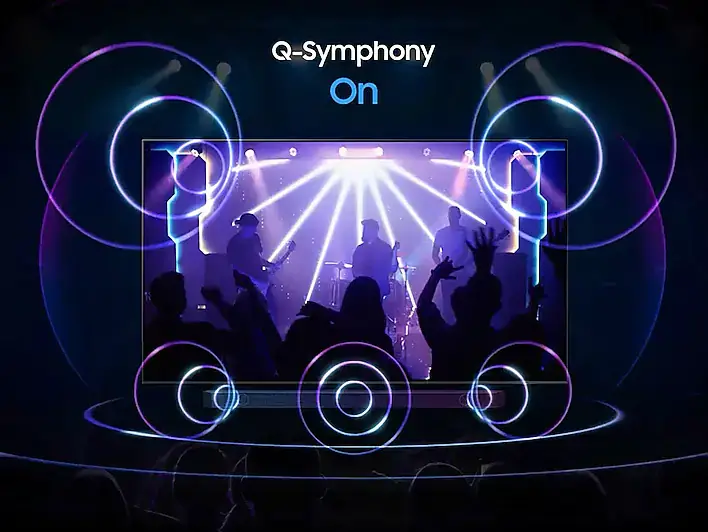
Overall Audio Performance Impressions
Overall the S95C’s sound output was good. The TV can get loud enough with little distortion and compression towards the higher volume levels. Dialog was distinct and clear no matter the source material. The obvious weaknesses were the absence of directional sound and surround action as well as mediocre bass performance. More or less what you should expect, even from the most advanced TV systems nowadays.
As a result, if you plan on using this TV in a home theater or entertainment area then a soundbar or some short or a dedicated surround system is highly recommended.
Ports and Connectivity
If there is one thing that we really missed last year in the S95B that surely was the One Connect Box which we thought that Samsung started to phase out from all their TVs. Thankfully it seems that Samsung listened to our cries and brought it back for the S95C. As a result all ports are separately on this box with only a single USB-C and the Once Connect Box connector on the back of the TV itself.
So what do we get on this separate box? From left to right, there is an Ethernet port for wired connection to your network, a digital optical audio output, the usual antenna/cable port, an Ex-Link jack, two USB Type-A ports, four HDMI inputs, another USB Type-A and the One Connect port that connects this box to the TV itself.
HDMI Specifications
All four HDMI ports are version 2.1 with 48Gbps of bandwidth due to the use of Samsung’s own SoC making Samsung along with LG the only brands to support the full 48Gbps bandwidth in all four of their ports.
The HDMI ports are v2.1 meaning that they support all new and old features including 4K@120Hz and 4K@144Hz, ARC, eARC, ALLM, VRR, G-Sync, FreeSync, HFR and HDMI-CEC.
Connectivity Observations
Lastly the Ethernet port for one more year will only support up to 100Mbps. This is a real shame but not entirely surprising given the fact that all manufacturers still include 100Mbps adapters in their TVs. We don’t believe that upgrading these ports to Gbit speeds would up the cost so much. And with streaming requirements increasing every single year this change should have been made some time ago. Let’s hope that manufacturers will finally decide to upgrade their Ethernet adapters to gigabit speeds.
Wireless Capabilities
When it comes to its wireless capabilities the Samsung S95C supports WiFi5 (802.11ac) along with Bluetooth 5.2 which is the same as the S95B had, so no changes here.
OS, Apps and Features
In terms of extra features things are a bit straightforward as we do not find huge differences from last year. Yes, we get the latest 2023 version but if you have used the 2022 version you will fail to find any meaningful changes.

Tizen 2023
The new Tizen occupies the whole screen instead of being a tile based row at the bottom of the screen, exactly as Google TV and webOS are lately.
It seems that smart TV platforms opt for a more personalized experience and as such the new OS tries to provide you with options that are tailored for your viewing habits. As such there are personalized ads, recommendations based on your viewing patterns both for streaming services and broadcasting channels and even shopping suggestions.
If you have used Tizen before 2022, the new version may feel a bit chaotic at first. This was the same with Google TV and webOS when they changed into a full screen UI and certainly you will need to spend some time with it to get your bearings. But once you get the hung of it, it is easier to navigate than it may seem.
Samsung Smart TV Hub
The new Samsung Smart TV Hub is separated in different sections and it allows you to navigate easily through all of them. At the left of the screen there is a single column with a few central selections while the rest of the screen is divided in rows with streaming services, apps and other functions and features available.
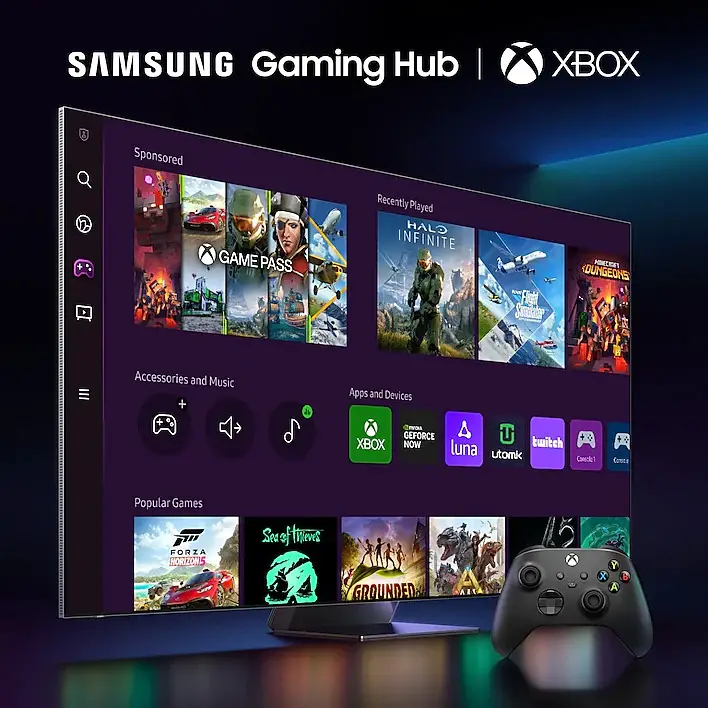
After trying both the latest Google TV and webOS we can say that the new Tizen is not all that different. Obviously the layout is tailored to Samsung’s needs but in essence it offers the same thing. Navigation was smooth enough and jumping from one app to the other was relatively fast and with no obvious lags or delays.
Game Bar 3.0
Let’s go over some of the features we find this year and we will start with the Game Bar. In 2023 this feature is now in its 3.0 version. This is an on-screen menu that lets you make real-time adjustments to screen ratio, input lag check, FPS, HDR, wireless headset settings and more. This can be a really handy feature to gamers as you don’t have to mess with menus every time you want to check on a specific setting. With this quick feature you have everything in front of you with the click of a button.
In the new Game Bar 3.0 you get MiniMap sharing and Virtual Aim Point for gaming. And you should keep in mind that Samsung TVs remain the only ones that include Xbox’s Game Pass.
Streaming Capabilities
When it comes to content the Tizen platform is famous for it’s enormous support from developers. The S95C offers practically all known services and platforms you can think of. Netflix, Apple TV, Disney Plus, Youtube, Amazon, Hulu, Rakuten, Demand 5 and BBC iPlayer are just a few of the big names available. There is also Samsung TV plus which offers hundreds of subscription-free channels to choose from. Many of these services can playback in both 4K with HDR like Netflix and Amazon but this very much app dependent.
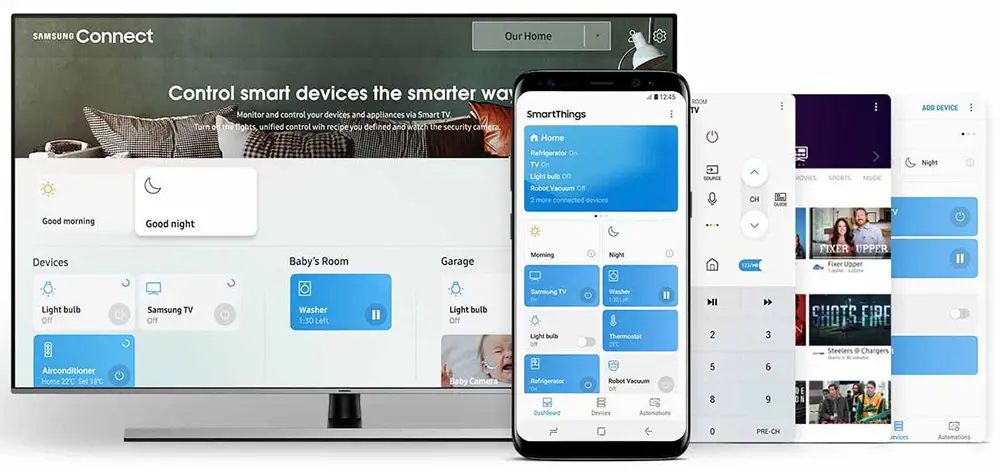
SmartThings Integration
A function that returns for another year is SmartThings integration. With it you can make your TV the central hub of all your smart houses devices. These can be lights, electronic locks, alarms, vacuum robots, thermostats and everything that supports the SmartThings platform. For 2023 Samsung added Matter and Thread integration meaning you can control such devices from a single app instead of multiple ones and there is no need for an additional dongle as it is built-in the TV itself.
Voice Control
Obviously another feature that is not missing is voice control. It seems that Samsung is really trying to market their own Bixby service but even if you are not very fond of that there is Amazon’s Alexa or Google Assistant to choose from. While if you are an Apple guy then don’t get disappointed as there is also Airplay 2 support and you can even use Siri through it for your voice commands. Unfortunately while Airplay is available HomeKit is not, something that hasn’t really changed from last year.
Multi-View & Tap-View
Another feature that we got some time ago and seems to be a standard now is Multi-View. Although at it’s core this is not something entirely new Samsung took it a step further. Multi-View is basically a more advanced screen mirroring program. But with it instead of just simply projecting the screen from your mobile device on the TV you can choose to have two screens showing both TV content and what your mobile device shows.
In addition to Multi-View there is also Tap View and with it you can mirror your phone on your TV with just a tap to continue enjoying movies, music, and apps on the bigger screen within seconds.
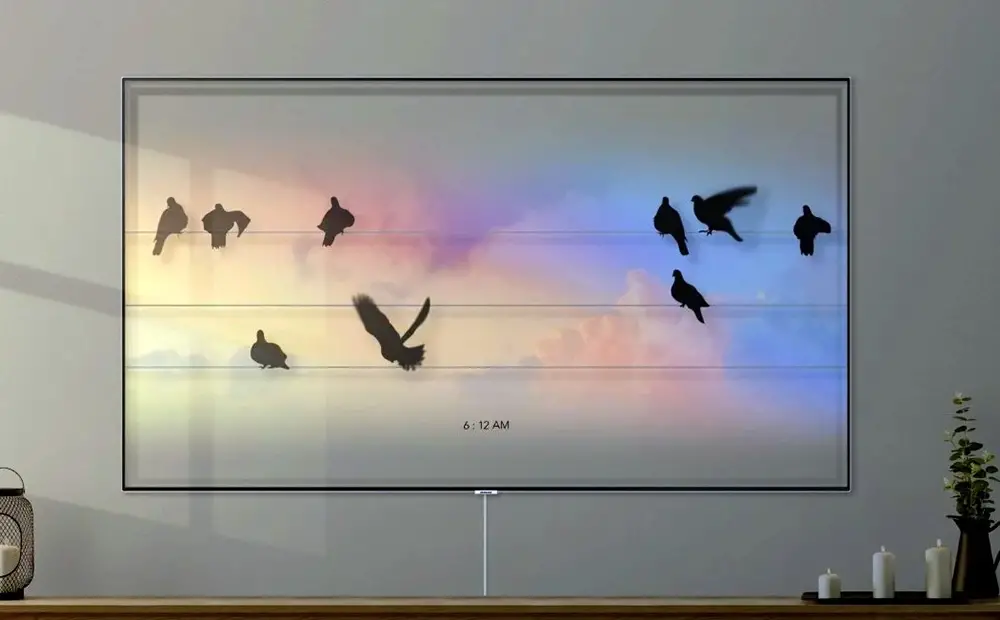
Ambient Mode+
Another returning feature is Ambient Mode+. This is a slightly more enhanced version of the Ambient Mode we get in many Samsung models for the last few years. With the plus version except from the ability to display various images on the TV when not in use it can also project various information including weather updates, news headlines, photos and music.
Samsung Health
Samsung Health is another returning feature. The last couple of years, with the coronavirus pandemic, many people were staying indoors so Samsung thought that exercise at home would be on the rise. So many of their TVs came with Samsung’s program in order to stay in shape. It seems that Samsung liked it so much they made it a standard feature.
Various Other Features
Other interesting new functions include a smart calibration function that works in combination to your smartphone. And also it seems that the new Samsung TVs have now access to the Philips Hue Sync app.
Overall not many changes here although to be honest the 2022 Samsung TVs were already fully packed with features. Some minor additions and upgrades are always welcome but looking the Tizen platform as a whole it remains an impressive piece of software that will give you extraordinary flexibility and options.
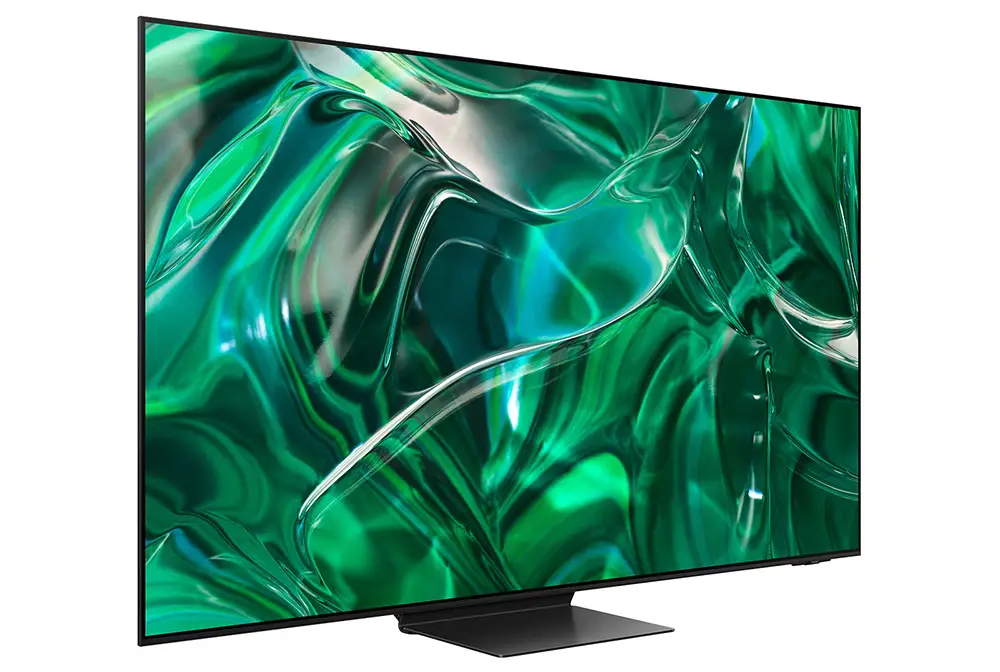
Final Thoughts
There was a lot of talk last year about the S95B and not always for good reasons. Obviously the TV had some major strengths but Samsung shot their legs due to their own sense of superiority. This year it feels like they have learned from their mistakes and they did fix everything that we didn’t like in the S95B.
Coming with a premium design and adding the One Connect Box was the right move. Its improved brightness and 144Hz support were the obvious enhancements over last year while in all other areas it managed to retain its top performing characteristics.
On the other hand, as bright as the TV may be its aggressive ABL may be a bit too obvious to the eye which can be slightly distracting. Also Samsung ditching DTS is low point for them while their refusal to add Dolby Vision is also more of a rival thing than anything else. Lastly as everything OLED, the TV should be handled with care to avoid any potential burn-in.
Reaching the end of our review we have only good things to say about this TV. Samsung did all the right moves this year and created a flagship that truly shows what QD-OLED is all about. And it really makes us wonder how much more they will be able to improve this in the years to come. From all the above the Samsung S95C gets our highest recommendation.
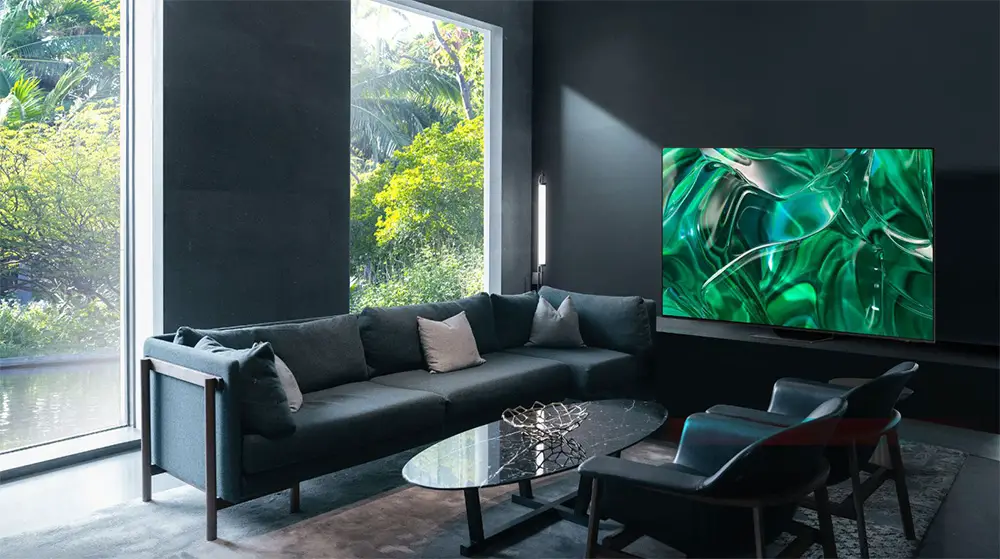
For more reviews you can check our dedicated 4K QD-OLED TV reviews list or even look at our Product Reviews Table where you can find the brand and specific product you are looking for.
Cheapest Places to Buy :
*We are a reader-supported website. When you buy through links on our site, we may earn a small affiliate commission at no extra cost to you. Home Media Entertainment does not accept money for reviews.*

Thank you for sharing your review of the S95C, Stratos. It’s good to know that Samsung made significant improvements to the QD-OLED technology. Also I love their One Connect Box, and I was also a bit disappointed that the S95B didn’t have that. Now they have seriously made me think about this one.
Hey Anoth. The S95C is a very good improvement over what the S95B was. Samsung did all the right moves. Obviously as with all new technologies their first generation of QD-OLED was a bit rough around the edges and the new S95C shows that the technology starts to mature.
The S95B was already amazing and it is surprising how Samsung managed to make the new one even brighter. I am really curious how the S95C will compare to the likes of LG G3, Sony A95L and the new Panasonic flagship. Are you going to review these? I would really like to see a comparison between all of them.
We are going to review some of them when we get our hands on them so stay tuned.
The S95C is an impressive TV and has features I wish my LG C2 OLED had. But the lack of Dolby Vision will remain a deal breaker for me for ever. I guess many buyers don’t consider this or even know. Would be good if reviewers highlighted how this impacts day to day viewing rather than just stating that it is absent. I watch a lot of streaming content in 4K, like Amazon Prime, and much is Dolby Vision HDR which is the biggest single enhancement to picture quality. Presumably the S95C would simply show without HDR as it can’t decode. It is a very big deal.
Hello John. I do agree that Samsung is shooting themselves in the foot by being so stubborn with Dolby Vision. But you know what? Sales is what drives their design decisions and when Samsung remains number 1 TV brand for so many years they have the luxury to make such decisions. Unfortunately the number of people that care for all these Dolby Vision, HDR, HDR10+ mumbo jumbo is very low compared to the number of people that just turn on the TV and watch a show in a streaming service without caring about image quality, audio codecs and all these.
So as long as Samsung sees that sales remain high they do not need to change this strategy. And will push their own rules to the market. Because after all, it is all about the money. And Samsung obviously don’t want to pay for Dolby Vision royalties.